
Tavush is a province of Armenia located at the northeast of Armenia, bordered by Georgia from the north and Azerbaijan from the east. Internally, Tavush borders the Gegharkunik Province from the south, Kotayk Province from the southwest, and the Lori Province from west. The capital and largest city of the province is the town of Ijevan.
Mamikonian, or Mamikonean, was an aristocratic dynasty which dominated Armenian politics between the 4th and 8th centuries. They were the most notable noble house in Early Christian Armenia after the ruling Arsacid dynasty and held the hereditary positions of sparapet and dayeak, allowing them to play the role of kingmaker for the later Armenian kings. They ruled over extensive territories, including the Armenian regions of Tayk, Taron, Sasun, and Bagrevand, among others. The Mamikonians had a reputation as supporters of the Roman Empire in Armenia against Sasanian Iran, although they also served as viceroys under Persian rule. Their influence over Armenian affairs began to decline at the end of the 6th century and suffered a final, decisive blow after a failed rebellion against Arab rule over Armenia in 774/75.
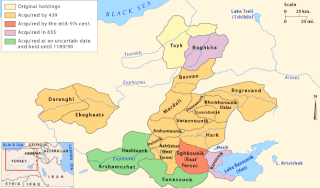
Taron was a canton of the Turuberan province of Greater Armenia, roughly corresponding to the Muş Province of modern Turkey.
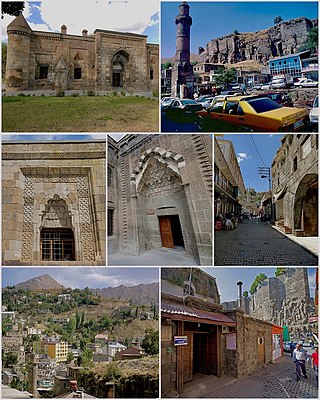
Bitlis is a city in southeastern Turkey. It is the seat of Bitlis District and Bitlis Province. Its population is 53,023 (2021). The city is located at an elevation of 1,545 metres, 15 km from Lake Van, in the steep-sided valley of the Bitlis River, a tributary of the Tigris. The local economy is mainly based on agricultural products which include fruits, grain and tobacco. Industry is fairly limited, and deals mainly with leatherworking, manufacture of tobacco products as well as weaving and dyeing of coarse cloth. Bitlis is connected to other urban centres by road, including Tatvan on Lake Van, 25 km to the northeast, and the cities of Muş (Mush), 100 km northwest, and Diyarbakır, 200 km to the west. The climate of Bitlis can be harsh, with long winters and heavy snowfalls. Summers are hot, and often humid. Since the local elections of March 2019, the Mayor of Bitlis is Nesrullah Tanğlay.
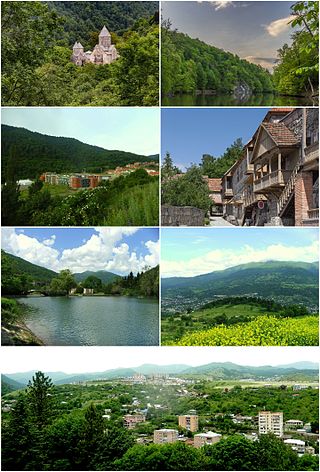
Dilijan is a spa town and urban municipal community in the Dilijan Municipality of the Tavush Province of Armenia. The town is one of the most important resorts in Armenia, situated within the Dilijan National Park. The forested town is home to numerous Armenian artists, composers, and filmmakers and features some traditional Armenian architecture. The town is often referred to as the Armenian Switzerland or Little Switzerland by the locals.

Muş is a city in eastern Turkey. It is the seat of Muş Province and Muş District. Its population is 120,699 (2022). Almost all of its population consists of Kurds.
Tondrakians were members of an anti-feudal Christian sect that flourished in medieval Armenia between the early 9th and the 11th century, centered on the district of Tondrak north of Lake Van.

Haghartsin is a 13th-century monastery located near the town of Dilijan in the Tavush Province of Armenia. It was built between the 10th and 13th centuries ; much of it under the patronage of the Bagratuni dynasty.
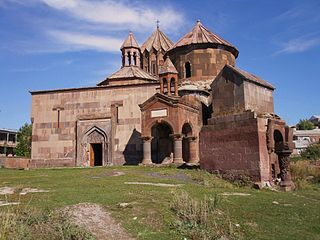
The Harichavank is 7th century Armenian monastery located near the village of Harich in the Shirak Province of Armenia. The village is 3 km southeast of the town of Artik.
Zenob Glak was an Armenian historian who became the first abbot of the Glak monastery in the Taron region of Greater Armenia. He began the chronology that would become the History of Taron of John Mamikonean. .

Arabo or Arapo, born Arakel Mkhitarian, was an Armenian fedayi of the late 19th century. He was a member of the Armenian Revolutionary Federation (ARF) political party.
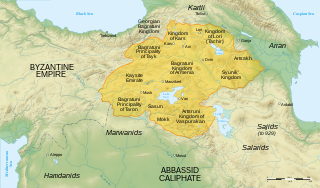
Bagratid Armenia was an independent Armenian state established by Ashot I Bagratuni of the Bagratuni dynasty in the early 880s following nearly two centuries of foreign domination of Greater Armenia under Arab Umayyad and Abbasid rule. With each of the two contemporary powers in the region—the Abbasids and Byzantines—too preoccupied to concentrate their forces in subjugating the region, and with the dissipation of several of the Armenian nakharar noble families, Ashot succeeded in asserting himself as the leading figure of a movement to dislodge the Arabs from Armenia.

Haghartsin is a village in the Dilijan Municipality of the Tavush Province of Armenia. The 13th-century Haghartsin Monastery is located around 8 km northwest of the village.

Surb Karapet Monastery of Mush was an Armenian Apostolic monastery in the historic province of Taron, about 30 km (19 mi) northwest of Mush (Muş), in present-day eastern Turkey.
Yeghrdut monastery was an Armenian monastery in the western part of Muş province of modern Turkey, approximately 22 km northwest of Muş city.
Saint Hakob of Akori Monastery, was an Armenian monastery located in the southeastern part of the historic region of Surmali. The monastery was located 4.7 kilometers southwest of Akori, a village at the northeastern slope of Mount Ararat. Destroyed by an earthquake and avalanche in 1840, Akori was later rebuilt. It is known today as Yenidoğan and remains a small Kurdish village.

Arakelots Monastery was an Armenian monastery in the historic province of Taron, 11 km south-east of Mush (Muş), in present-day eastern Turkey. According to tradition, Gregory the Illuminator founded the monastery to house relics of several apostles. The monastery was, however, most likely built in the 11th century. During the 12th-13th centuries it was a major center of learning. In the following centuries it was expanded, destroyed and renovated. It remained one of the prominent monasteries of Turkish (Western) Armenia until the Armenian genocide of 1915, when it was attacked and subsequently abandoned. It remained standing until the 1960s when it was reportedly blown up. Today, ruins of the monastery are still visible.
The Bagratuni family tree describes the heritage of the Bagratuni family in Armenia. Bagratuni lineage also lays claim to the Georgian Bagrationi dynasty.
Diocese of Tavush is one of the newest dioceses of the Armenian Apostolic Church covering the Tavush Province of Armenia. The diocesan headquarters are located in the town of Ijevan. The seat of the bishop is the Surp Nerses Cathedral of Ijevan which was consecrated in 1998.
The 602 Surb Karapet Monastery earthquake took place in 602 and affected the Surb Karapet Monastery, located in the district of Taron.











